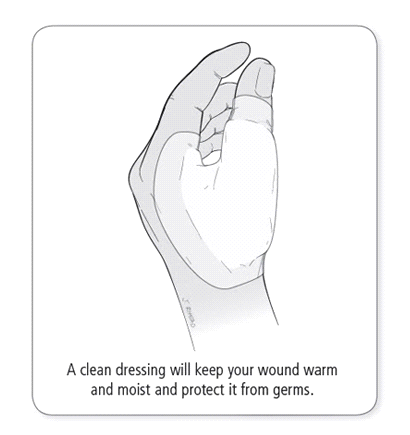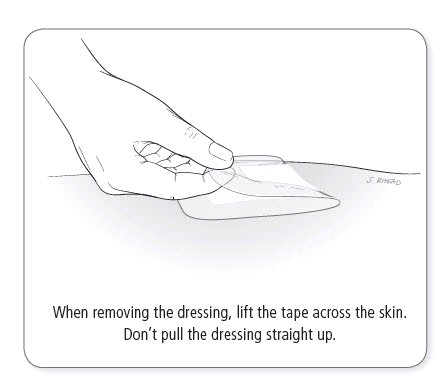What is a chronic wound?
A wound is any break in the skin or deep tissue. Normally the skin heals quickly on its own. Wounds that don’t heal easily are called chronic wounds. They require special care to heal. Chronic wounds can result from:
- Surgical wounds that reopen
- Skin that breaks down when there’s too much pressure over a bony area (pressure ulcers)
- Injury to the feet or legs from poor circulation (arterial or venous ulcers)
- Loss of circulation and feeling due to diabetes (diabetic ulcers)

Why isn’t my wound healing faster?
Sometimes bacteria (germs) are the problem. When you have an open wound, it’s easy for common bacteria from your skin to get inside. Bacteria in your wound is called contamination. Not all contamination is bad, though.
- If bacteria are in your wound, but are not reproducing and not causing a problem, this is called colonization.
- Infection means the bacteria are reproducing, so there are a lot more of them. They are invading the soft tissue and preventing healing.
Other factors that slow wound healing include:
- Poor nutrition
- Certain diseases, such as diabetes or diseases of the liver, kidney, or lungs
- Certain treatments, such as chemotherapy or radiation
- Smoking
- Obesity
How can I help my wound heal?
All wounds heal in the same way. First, new red tissue builds up in the bottom. Then new skin grows in from the edges and covers the red tissue. Your wound will heal fastest if you create the best conditions for new tissue to grow. This means keeping your wound clean, warm, and moist. Here’s what you should do:
- Wash your hands. The most important thing you and your caregivers can do to prevent infection is wash your hands. You can use soap and water, or an alcohol-based hand rub. Wash before and after touching your wound.
- Keep a clean dressing on your wound. Dressings keep out germs and protect the wound from injury. They also help absorb fluid that drains from the wound and could damage the skin around it.
- Be careful. Protect the wound from trauma or injury. Don’t let anything touch it or bump it.
- Eat right. Eating the right foods gives your body the building blocks it needs to heal. A list of foods for good wound healing is found here.
- If your wound is on your foot or ankle, keep it free from contamination from water washing off the upper body from a shower or bath. The wound should be kept dry with waterproof covers or elevated in a shower chair to keep contaminated water from the upper body from draining over the wound.
Changing your dressing
Keeping a clean dressing on your wound will help it heal. Your healthcare providers can show you how to change your dressing, and let you know how long to keep each dressing on. They will recommend specific products to use.
Prepare
- Clean your work area
- Gather your supplies (use the items listed below)


Remove the old dressing
- Wash your hands with soap and warm water or an alcohol-based hand rub.
- Put on the gloves if they are recommended.
- Slowly lift the corners or edges of the dressing or tape. If it sticks to the skin, dab the edges with an adhesive remover, a moistened gauze pad, or a moistened paper towel
- Hold down the skin surrounding the bandaged area. Gently and slowly remove the tape or dressing. Lift the tape across the skin rather pulling away from the skin.
- Lift the edges of the dressing toward the center of the wound, then gently lift it from the wound.
- If the dressing sticks to the wound, soak it with saline solution to help loosen it.
- Carefully discard the old dressing into a plastic trash bag and tie it closed. Put that bag into a second plastic bag and throw it away.
- Remove the gloves and wash your hands again.
Clean the wound
After you remove the dressing, you may see a thick, yellow, gummy film over your wound. This is good. It means the dressing is keeping the wound moist, which helps it to heal. Gently wash it off when you change the dressing. Follow these steps:
- Put on new gloves.
- Place a towel under the wound.
- Wet a gauze sponge or pad with saline or water. Gently clean the wound.
- Start at the center of the wound. Dab in circles out to 1 inch past the edge of the wound. Do not go from the outer edges of the wound back toward the center. This could spread germs into the wound.
- Be sure to clean away any liquid draining from the wound.
- Throw out your cloth or gauze and get a new one as often as you need to.
- Rinse the wound again with a new gauze pad to remove any loose debris not removed by the first cleaning.
- Throw the cleaning materials into the plastic trash bag.
- Dry the skin surrounding the wound by patting it with a soft, clean towel.
- Check the wound for redness, drainage, swelling, or odor.
- New tissue at the bottom of the wound should be light red or pink and look lumpy or glossy. Do not disturb this tissue. It is very fragile and will bleed easily.
Apply a new dressing
- Open the new dressing and remove it from the package. Touch only the corners of the dressing. Cut it to size if necessary.
- Apply a skin barrier to the skin around the wound.
- Carefully center the dressing over the wound.
- Secure the dressing in place with tape.
- Remove the gloves and wash your hands.
Making saline solution
- Get a clean storage container and mixing utensil. Either wash them in the dishwasher or boil them for 5 minutes.
- Use 1 quart (4 cups) of distilled water, or boil 1 quart of tap water for 5 minutes. Do not use well water or sea water.
- Add 2 teaspoons of table salt.
- Mix the water and salt well until the salt is completely dissolved.
- Cool to room temperature before using.
Saline solution can be stored at room temperature in a tightly covered glass or plastic bottle. You can keep it for up to one week. Always label it and include the date.
When should I call my healthcare providers?
The following symptoms could mean that your wound is infected and you need to contact your healthcare provider:
- Fever or chills, nausea or vomiting
- Increased pain at the wound site
- Redness or swelling around or spreading out from the wound site
- The wound site or surrounding area feels warm to the touch
- Foul odor coming from the wound after the wound has been cleaned
- Any change in color or amount of drainage from the wound
Eating to help you heal
Having a wound puts extra demands on your body. To heal, you need more calories and more nutrients. Wounds heal faster if you get enough of the right foods — and if you don’t, they heal more slowly. Follow the guidelines below to promote healing.
- Protein. Protein provides the building material for muscle and skin repair. It also helps boost immunity. Eat 3 to 4 servings per day. (One serving is 3 to 4 ounces.) Good sources of protein include:
- Lean animal meat, such as beef, pork, chicken, or fish
- Dried beans, peas, lentils, or tofu
- Nuts, peanut butter, or seeds
- Cheese, yogurt, or eggs
- Carbohydrates. Carbohydrates supply the energy your body needs to heal. Good choices include:
- Whole grain breads and cereals
- Potatoes, rice, or pasta
- A variety of fruits and vegetables
- Foods with vitamin A, such as bright orange fruits and vegetables, and dark green leafy vegetables
- Foods with vitamin C, such as citrus fruits, peppers, tomatoes, strawberries, cantaloupe, and broccoli
- If you have diabetes, carefully follow the diet and medications recommendations for your diabetes. If your wounds are not healing, follow up with your dietitian or other healthcare provider.
- Milk and dairy products. These are good sources of both carbohydrates and protein. Unless your doctor says not to eat dairy, be sure to include at least 3 servings per day. One serving of milk or yogurt is one cup. Soymilk can be substituted for regular milk.
- Water. Water replaces fluid lost with draining wounds. Make sure you drink about 6 to 8 cups of liquids each day, unless your doctor tells you otherwise.
Be sure to get enough healthy foods
Some people have trouble eating enough at meals to promote wound healing. These ideas that may help:
- Eat smaller meals more often. It may be easier to eat 6 small meals per day rather than 3 larger meals.
- Eat healthy snacks. You can get more of the nutrition you need by snacking between meals on healthy foods such as:
- Cheese and crackers
- Cottage cheese and fruit
- Half a sandwich and a small piece of fruit
- Peanut butter or nuts and sliced apples
- Granola bars and fresh fruit
- Vitamins and minerals. You can get most of the vitamins and minerals you need from eating a well-balanced diet, as described above. Be sure to eat at least one serving per day of red meats, fortified cereals, or dark green leafy vegetables.
- If you’re not eating at least 5 servings a day of fruits and vegetables, your doctor or dietitian may recommend a daily multi-vitamin or an extra vitamin D supplement if your levels are low. Only take other vitamins or minerals of recommended by a healthcare provider.
If you need further help getting enough calories and protein in your diet, contact a dietitian. Your healthcare providers can help you find one.